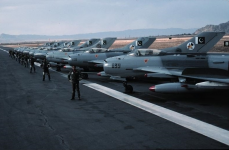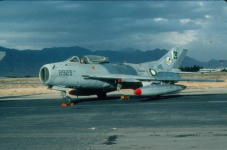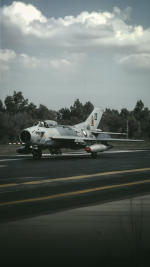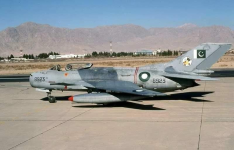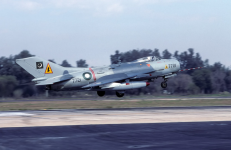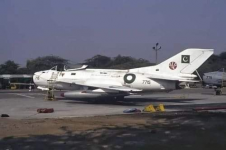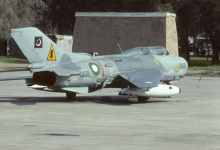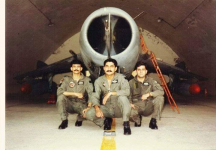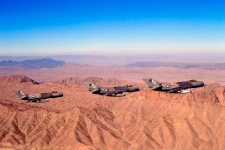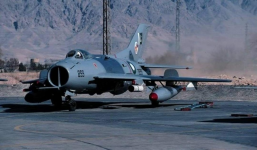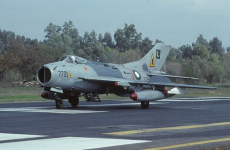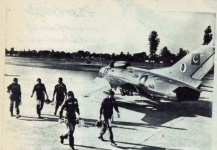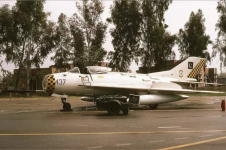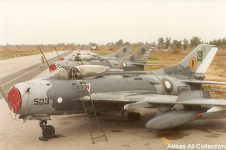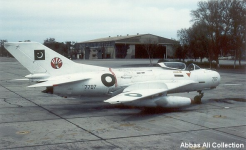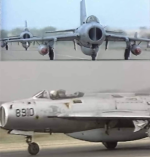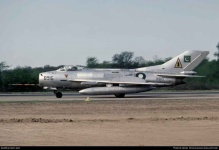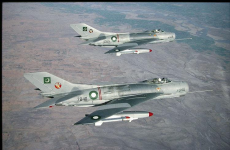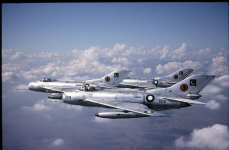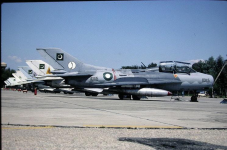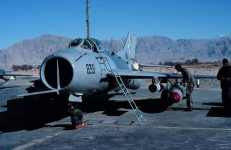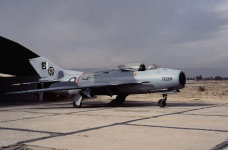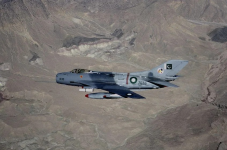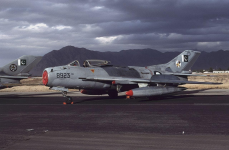- Jan 25, 2024
- 111,083
- 353
F-6 Aircraft of Pakistan Air Force
Columnist Gp Capt SM HALI remembers the Chinese F-6 aircraft in the PAF
The mach 1.4 F-6 Day Fighter is an export designation of the Chinese-built J-6 (Fighter aircraft 6) which was originally designed as MiG-19 in the USSR, its Soviet prototype having flown for the first time in September, 1953.
Immediately after the 1965 Indo-Pak War, USA placed an embargo on the supply of weapons to both countries. Pakistani defence planners selected the F-6 aircraft as an addition to the PAF inventory. Thus its induction commenced on 30 December, 1965. Initially 72 aircraft were procured with subsequent additions bringing the total to 253 aircraft. At its peak, the F-6 aircraft equipped ten Fighter Squadrons of Pakistan Air Force.
PAF pilots have now flown this aircraft for more than thirty-four years. They mastered this twin engined pack of roaring power in a considerably short time. On 09 March, 1968, PAF F-6s participated in an impressive Fire-Power display at the Jamrud Firing Range near Peshawar organised for the visiting Iranian monarch, Raza Shah Pahelvi. In 1969, PAF formed an aerobatics team named ‘Rattlers’. The team comprised four F-6 aircraft painted black. On 14 March, 1969, the team performed formation aerobatics in a thrilling display of speed control and co-ordination in an air display organized for the visiting Soviet Minister of Defence, Marshal Grechko.
While the PAF pilots gained expertise on this thrilling but difficult and demanding weapon system, PAF’s engineers and technicians carried out a number of indigenous modifications and improvements to make the F-6 more effective and enhance its roles of air superiority and ground attack. The major upgrading and innovative modifications include the provision of western avionics, Martin and Baker ejection seats, the AIM-9 Sidewinder air-to-air missile, French 68 mm rockets, additional under wing tanks and under-belly ‘Gondola’ fuel tanks and a special ground-power unit for instantly starting its twin engines to shorten ‘scramble’ time.
PAF’s expertise on the F-6 was fully tested during the 1971 Indo-Pak War. Its three F-6 squadrons, Nos 11, 23 and 25 gave an excellent account of themselves: flying 945 sorties comprising 735 hours and destroying numerous enemy tanks, armoured cars and field guns during the close support missions. In air combat, F-6 pilots shot down eight Indian Air Force fighter aircraft including a superior MiG-21 and damaged five.
On 04 December, Flight Lieutenant Javed Latif of No 23 Squadron shot down an SU-7 while it was attacking the PAF airfield at Risalewala. Its pilot Flight Lieutenant Harvinder Singh was killed in action. On 04 December, Flying Officer Qazi Javed of No 25 Squadron shot down an Indian Hunter when it came to attack PAF airfield at Mianwali. Its pilot Flight Lieutenant Vidya Dhar Shankar was also killed in action.
On 05 December, Wing Commander Saad A Hatmi, the Officer Commanding of No 25 Squadron and his Number two, Flight Lieutenant Shahid Raza chased two IAF Hunters and shot them down close to Sakesar. Their pilots Flight Lieutenants G.S. Rai and K.L. Malkani were both killed in action.
On 07 December, Flight Lieutenant Atiq Sufi of No 11 Squadron shot down an IAF SU-7 near the battle front at Samba. Its pilot Flight Lieutenant Jiwa Singh was killed in action.
On 08 December, Wing Commander S. M. Hashmi, Officer Commanding of No 23 Squadron shot down two IAF SU-7s which were attacking Risalewala airfield.
On 14 December, Flight Lieutenant Aamer A Sharif of No 11 Squadron engaged a superior IAF MiG-21 and after a classic battle, shot it down near Niankot.
All three squadrons received battle honours for the 1971 War, while three F-6 pilots were awarded gallantry medals.
Todate F-6 aircraft have flown more than 400,000 hours. The Pakistan Aeronautical Complex Kamra’s F-6 Rebuild Factory, which was inaugurated in 1980, has played a major role in giving the F-6 aircraft a new lease of life by completely over-hauling it.
Today F-6 aircraft are in the twilight of their service in PAF but they still compete actively with the more modern weapons systems. PAF is presently maintaining two Squadrons: No 17 and 23 with F-6s which are active in guarding the aerial frontiers of PAF.
The Shenyang J-6 (Chinese: 歼-6; designated F-6 for export versions; NATO reporting name: Farmer).
It is the Chinese-built version of the Soviet MiG-19 'Farmer' fighter aircraft, the world's first mass-produced supersonic aircraft.
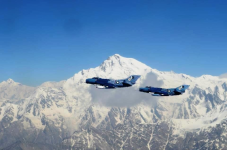
Columnist Gp Capt SM HALI remembers the Chinese F-6 aircraft in the PAF
The mach 1.4 F-6 Day Fighter is an export designation of the Chinese-built J-6 (Fighter aircraft 6) which was originally designed as MiG-19 in the USSR, its Soviet prototype having flown for the first time in September, 1953.
Immediately after the 1965 Indo-Pak War, USA placed an embargo on the supply of weapons to both countries. Pakistani defence planners selected the F-6 aircraft as an addition to the PAF inventory. Thus its induction commenced on 30 December, 1965. Initially 72 aircraft were procured with subsequent additions bringing the total to 253 aircraft. At its peak, the F-6 aircraft equipped ten Fighter Squadrons of Pakistan Air Force.
PAF pilots have now flown this aircraft for more than thirty-four years. They mastered this twin engined pack of roaring power in a considerably short time. On 09 March, 1968, PAF F-6s participated in an impressive Fire-Power display at the Jamrud Firing Range near Peshawar organised for the visiting Iranian monarch, Raza Shah Pahelvi. In 1969, PAF formed an aerobatics team named ‘Rattlers’. The team comprised four F-6 aircraft painted black. On 14 March, 1969, the team performed formation aerobatics in a thrilling display of speed control and co-ordination in an air display organized for the visiting Soviet Minister of Defence, Marshal Grechko.
While the PAF pilots gained expertise on this thrilling but difficult and demanding weapon system, PAF’s engineers and technicians carried out a number of indigenous modifications and improvements to make the F-6 more effective and enhance its roles of air superiority and ground attack. The major upgrading and innovative modifications include the provision of western avionics, Martin and Baker ejection seats, the AIM-9 Sidewinder air-to-air missile, French 68 mm rockets, additional under wing tanks and under-belly ‘Gondola’ fuel tanks and a special ground-power unit for instantly starting its twin engines to shorten ‘scramble’ time.
PAF’s expertise on the F-6 was fully tested during the 1971 Indo-Pak War. Its three F-6 squadrons, Nos 11, 23 and 25 gave an excellent account of themselves: flying 945 sorties comprising 735 hours and destroying numerous enemy tanks, armoured cars and field guns during the close support missions. In air combat, F-6 pilots shot down eight Indian Air Force fighter aircraft including a superior MiG-21 and damaged five.
On 04 December, Flight Lieutenant Javed Latif of No 23 Squadron shot down an SU-7 while it was attacking the PAF airfield at Risalewala. Its pilot Flight Lieutenant Harvinder Singh was killed in action. On 04 December, Flying Officer Qazi Javed of No 25 Squadron shot down an Indian Hunter when it came to attack PAF airfield at Mianwali. Its pilot Flight Lieutenant Vidya Dhar Shankar was also killed in action.
On 05 December, Wing Commander Saad A Hatmi, the Officer Commanding of No 25 Squadron and his Number two, Flight Lieutenant Shahid Raza chased two IAF Hunters and shot them down close to Sakesar. Their pilots Flight Lieutenants G.S. Rai and K.L. Malkani were both killed in action.
On 07 December, Flight Lieutenant Atiq Sufi of No 11 Squadron shot down an IAF SU-7 near the battle front at Samba. Its pilot Flight Lieutenant Jiwa Singh was killed in action.
On 08 December, Wing Commander S. M. Hashmi, Officer Commanding of No 23 Squadron shot down two IAF SU-7s which were attacking Risalewala airfield.
On 14 December, Flight Lieutenant Aamer A Sharif of No 11 Squadron engaged a superior IAF MiG-21 and after a classic battle, shot it down near Niankot.
All three squadrons received battle honours for the 1971 War, while three F-6 pilots were awarded gallantry medals.
Todate F-6 aircraft have flown more than 400,000 hours. The Pakistan Aeronautical Complex Kamra’s F-6 Rebuild Factory, which was inaugurated in 1980, has played a major role in giving the F-6 aircraft a new lease of life by completely over-hauling it.
Today F-6 aircraft are in the twilight of their service in PAF but they still compete actively with the more modern weapons systems. PAF is presently maintaining two Squadrons: No 17 and 23 with F-6s which are active in guarding the aerial frontiers of PAF.
The Shenyang J-6 (Chinese: 歼-6; designated F-6 for export versions; NATO reporting name: Farmer).
It is the Chinese-built version of the Soviet MiG-19 'Farmer' fighter aircraft, the world's first mass-produced supersonic aircraft.

Source: https://www.PKDefense.com


